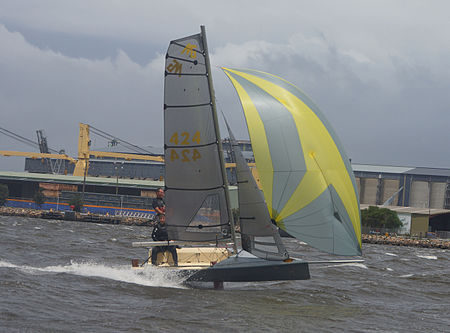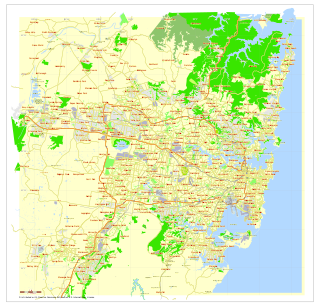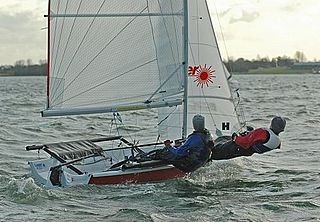

MG14 is a two-person skiff with a high-performance development hull, single trapeze and asymmetrical spinnaker.
The term skiff is used for a number of essentially unrelated styles of small boat. Traditionally, these are coastal craft or rivercrafts used for leisure, as a utility craft and for fishing, and have a one-person or small crew. Sailing skiffs have developed into high performance competitive classes. Many of today's skiff classes are based in Australia and New Zealand in the form of 12 ft, 13 ft, 16 ft and 18 ft skiffs. The 29er, 49er, SKUD and Musto Skiff are all considered to developed from the skiff concept, all of which are sailed internationally.

In sailing, the trapeze is a wire that comes from a point high on the mast, usually where the shrouds are fixed, to a hook on the crew member's harness at approximately waist level. The position when extended on the trapeze is outside the hull, braced against it with the soles of the feet, facing the masthead, and clipped on by a hook on the trapeze harness. This gives the crew member more leverage to keep the boat flat by allowing the crew member's centre of gravity to balance the force of the wind in the sails.
An asymmetrical spinnaker is a sail used when sailing downwind. Also known as an "asym" or "aspin", it can be described as a cross between a genoa jib and a spinnaker. It is asymmetric like a genoa, but, the asymmetrical spinnaker is not attached to the forestay over the full length of its luff, being rigged like a spinnaker. The asymmetrical spinnaker has a larger camber than a genoa, making it optimal for generating lift at larger angles of attack, but the camber is significantly less than that of a spinnaker.
It was originally developed in 1963 at Manly Sailing Club in Sydney as the Manly Graduate 14ft to be used as a stepping stone between the smaller Manly Junior and larger boats such as the 16ft Skiff. During its early history it had a double luff spinnaker, but is now rigged with an asymmetric spinnaker - giving great performance, ease of use and tactical gybing downwind.

Sydney is the state capital of New South Wales and the most populous city in Australia and Oceania. Located on Australia's east coast, the metropolis surrounds Port Jackson and extends about 70 km (43.5 mi) on its periphery towards the Blue Mountains to the west, Hawkesbury to the north, the Royal National Park to the south and Macarthur to the south-west. Sydney is made up of 658 suburbs, 40 local government areas and 15 contiguous regions. Residents of the city are known as "Sydneysiders". As of June 2017, Sydney's estimated metropolitan population was 5,230,330 and is home to approximately 65% of the state's population.

The Manly Junior is a junior racing dinghy class popular in Sydney Australia. It was designed in 1959 for younger sailors and the length was originally designed so that the boat could be stored vertically downstairs inside Manly Yacht Club. To provide as much performance as possible in a short length, the designer, Ralph Tobias used a "snub" bow.

A 16 ft Skiff is a class of three-person sailing dinghy with twin trapezes and a large asymmetrical spinnaker. The class is unique to Australia, where it is one of the most popular boats sailing with 95 boats registered in 12 clubs. The class has the largest fleet of high performance skiffs on the east coast of Australia. Due to the nature of only allowing two trapezes, the age of the sailors can vary between 15 and 60 years old, making it a versatile class of boat.
The MG14 is now a high performance machine, with performance to rival any other single trapeze boat of its size. Keeping the modest sail area, however, has ensured entry level skiff sailors, and older sailors, can still compete and race. It is a performance boat that places emphasis on technique, finesse and strategy - rather than brute force!
The class has various hull designs of similar performance, but with variances in stability or speed on certain wind angles and strength. The class has a tight set of rules so the boats can modernise but the older ones still remain competitive for many years. Because of this MG14s have good resale value.
It is a popular class with fleets in New South Wales, Queensland, Victoria and in the Australian Capital Territory.

New South Wales is a state on the east coast of Australia. It borders Queensland to the north, Victoria to the south, and South Australia to the west. Its coast borders the Tasman Sea to the east. The Australian Capital Territory is an enclave within the state. New South Wales' state capital is Sydney, which is also Australia's most populous city. In September 2018, the population of New South Wales was over 8 million, making it Australia's most populous state. Just under two-thirds of the state's population, 5.1 million, live in the Greater Sydney area. Inhabitants of New South Wales are referred to as New South Welshmen.

Queensland is the second-largest and third-most populous state in the Commonwealth of Australia. Situated in the north-east of the country, it is bordered by the Northern Territory, South Australia and New South Wales to the west, south-west and south respectively. To the east, Queensland is bordered by the Coral Sea and Pacific Ocean. To its north is the Torres Strait, with Papua New Guinea located less than 200 km across it from the mainland. The state is the world's sixth-largest sub-national entity, with an area of 1,852,642 square kilometres (715,309 sq mi).

Victoria is a state in south-eastern Australia. Victoria is Australia's smallest mainland state and its second-most populous state overall, making it the most densely populated state overall. Most of its population lives concentrated in the area surrounding Port Phillip Bay, which includes the metropolitan area of its state capital and largest city, Melbourne, Australia's second-largest city. Victoria is bordered by Bass Strait and Tasmania to the south, New South Wales to the north, the Tasman Sea to the east, and South Australia to the west.
The NS14 class is very similar to the MG14 - it has the same hull and working rig designs but that class does not allow spinnakers or trapezes. The NS14 and MG14 share the same restricted development rules about hull and working sail measurements. Several boats are registered to sail as both MG14 and NS14s.

The NS14 is an Australian restricted development class of sailing dinghy. Measuring 14 feet in length, the class was designed the 1960 and introduced at the Northbridge sailing club in Sydney, Australia, with control of the class transferred to the NS14 Association of New South Wales in 1965. Subsequently the boat was introduced to the other states, prior to being taken to New Zealand in 1995 and the United States in 1998.

A spinnaker is a sail designed specifically for sailing off the wind from a reaching course to a downwind, i.e. with the wind 90–180° off bow. The spinnaker fills with wind and balloons out in front of the boat when it is deployed, called flying. It is constructed of lightweight fabric, usually nylon, and is often brightly coloured. It may be optimised for a particular range of wind angles, as either a reaching or a running spinnaker, by the shaping of the panels and seams.












